ECU INFINITI G-COUPE 2012 Owners Manual
[x] Cancel search | Manufacturer: INFINITI, Model Year: 2012, Model line: G-COUPE, Model: INFINITI G-COUPE 2012Pages: 490, PDF Size: 3.73 MB
Page 22 of 490
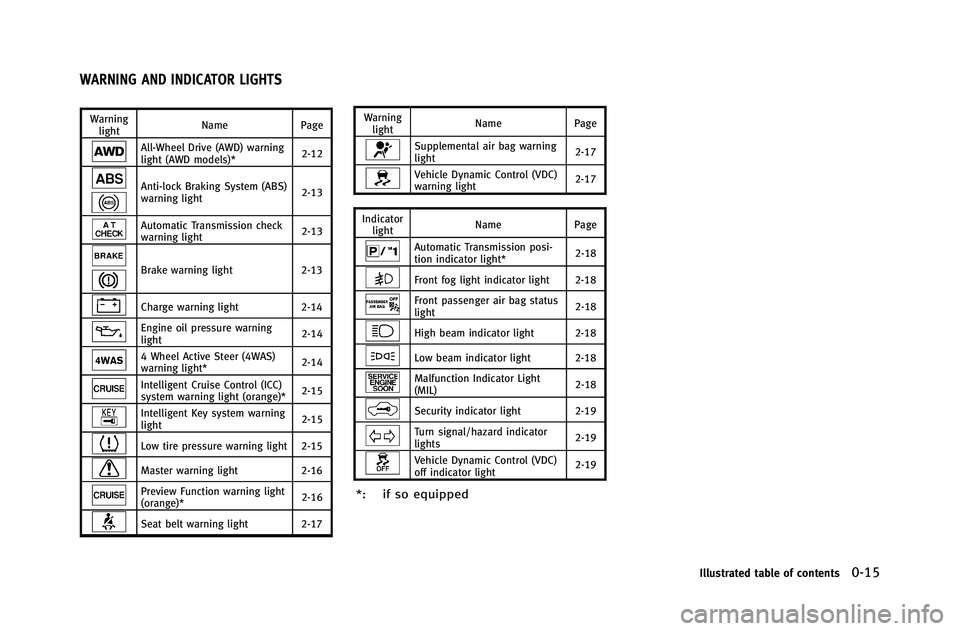
Warninglight Name
Page
All-Wheel Drive (AWD) warning
light (AWD models)* 2-12
Anti-lock Braking System (ABS)
warning light2-13
Automatic Transmission check
warning light
2-13
Brake warning light
2-13
Charge warning light2-14
Engine oil pressure warning
light 2-14
4 Wheel Active Steer (4WAS)
warning light*
2-14
Intelligent Cruise Control (ICC)
system warning light (orange)*2-15
Intelligent Key system warning
light2-15
Low tire pressure warning light 2-15
Master warning light
2-16
Preview Function warning light
(orange)* 2-16
Seat belt warning light 2-17 Warning
light Name Page
Supplemental air bag warning
light 2-17
Vehicle Dynamic Control (VDC)
warning light2-17
Indicator light Name Page
Automatic Transmission posi-
tion indicator light*
2-18
Front fog light indicator light 2-18
Front passenger air bag status
light2-18
High beam indicator light 2-18
Low beam indicator light 2-18
Malfunction Indicator Light
(MIL)2-18
Security indicator light 2-19
Turn signal/hazard indicator
lights2-19
Vehicle Dynamic Control (VDC)
off indicator light2-19
*: if so equipped
Illustrated table of contents0-15
WARNING AND INDICATOR LIGHTS
Page 25 of 490
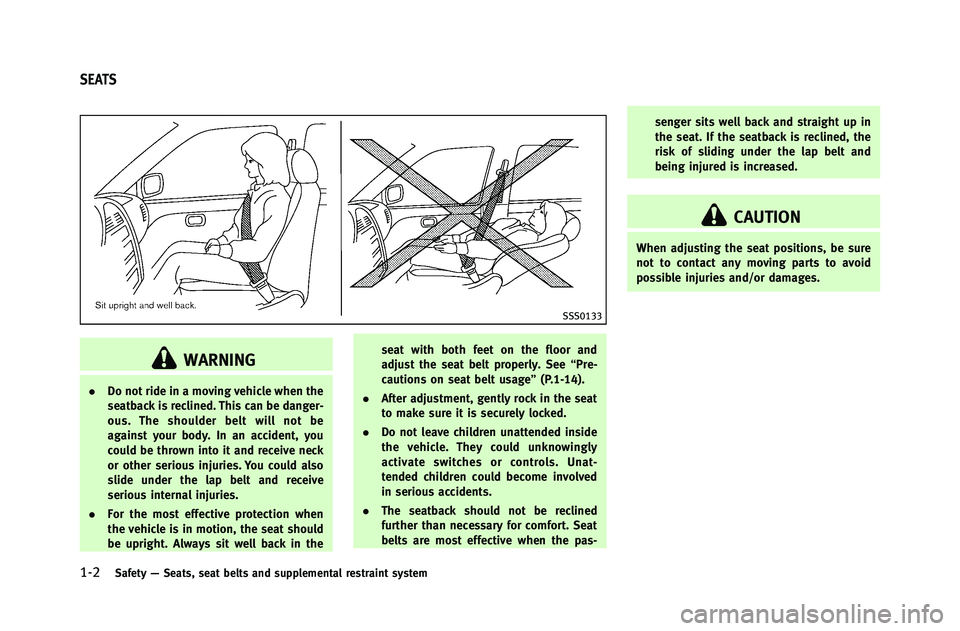
1-2Safety—Seats, seat belts and supplemental restraint system
SSS0133
WARNING
. Do not ride in a moving vehicle when the
seatback is reclined. This can be danger-
ous. The shoulder belt will not be
against your body. In an accident, you
could be thrown into it and receive neck
or other serious injuries. You could also
slide under the lap belt and receive
serious internal injuries.
. For the most effective protection when
the vehicle is in motion, the seat should
be upright. Always sit well back in the seat with both feet on the floor and
adjust the seat belt properly. See
“Pre-
cautions on seat belt usage” (P.1-14).
. After adjustment, gently rock in the seat
to make sure it is securely locked.
. Do not leave children unattended inside
the vehicle. They could unknowingly
activate switches or controls. Unat-
tended children could become involved
in serious accidents.
. The seatback should not be reclined
further than necessary for comfort. Seat
belts are most effective when the pas- senger sits well back and straight up in
the seat. If the seatback is reclined, the
risk of sliding under the lap belt and
being injured is increased.
CAUTION
When adjusting the seat positions, be sure
not to contact any moving parts to avoid
possible injuries and/or damages.
SEATS
Page 30 of 490
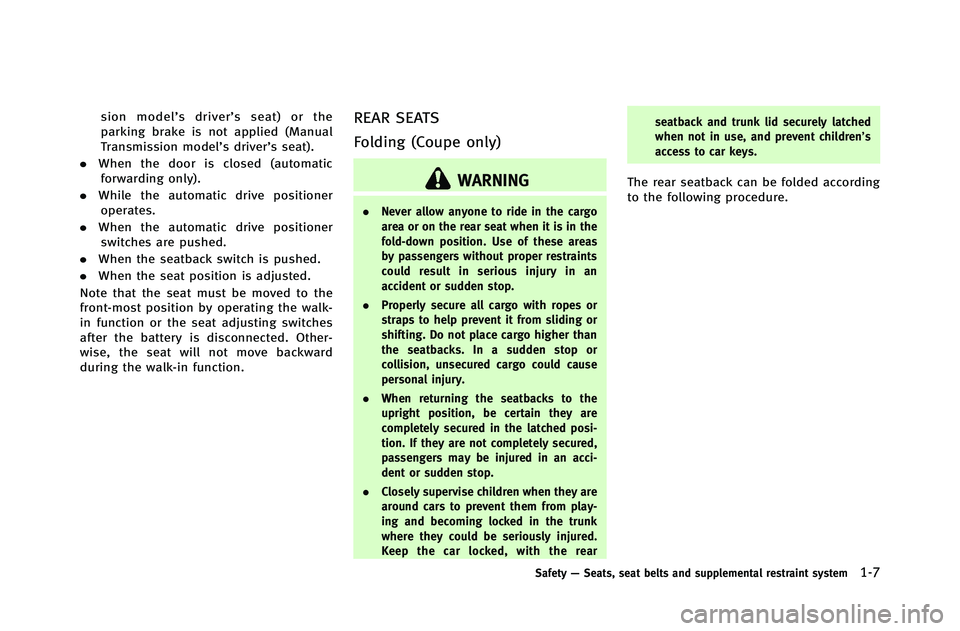
sion model’s driver’s seat) or the
parking brake is not applied (Manual
Transmission model’s driver’s seat).
. When the door is closed (automatic
forwarding only).
. While the automatic drive positioner
operates.
. When the automatic drive positioner
switches are pushed.
. When the seatback switch is pushed.
. When the seat position is adjusted.
Note that the seat must be moved to the
front-most position by operating the walk-
in function or the seat adjusting switches
after the battery is disconnected. Other-
wise, the seat will not move backward
during the walk-in function.REAR SEATS
Folding (Coupe only)
WARNING
. Never allow anyone to ride in the cargo
area or on the rear seat when it is in the
fold-down position. Use of these areas
by passengers without proper restraints
could result in serious injury in an
accident or sudden stop.
. Properly secure all cargo with ropes or
straps to help prevent it from sliding or
shifting. Do not place cargo higher than
the seatbacks. In a sudden stop or
collision, unsecured cargo could cause
personal injury.
. When returning the seatbacks to the
upright position, be certain they are
completely secured in the latched posi-
tion. If they are not completely secured,
passengers may be injured in an acci-
dent or sudden stop.
. Closely supervise children when they are
around cars to prevent them from play-
ing and becoming locked in the trunk
where they could be seriously injured.
Keep the car locked, with the rear seatback and trunk lid securely latched
when not in use, and prevent children’s
access to car keys.
The rear seatback can be folded according
to the following procedure.
Safety
—Seats, seat belts and supplemental restraint system1-7
Page 32 of 490
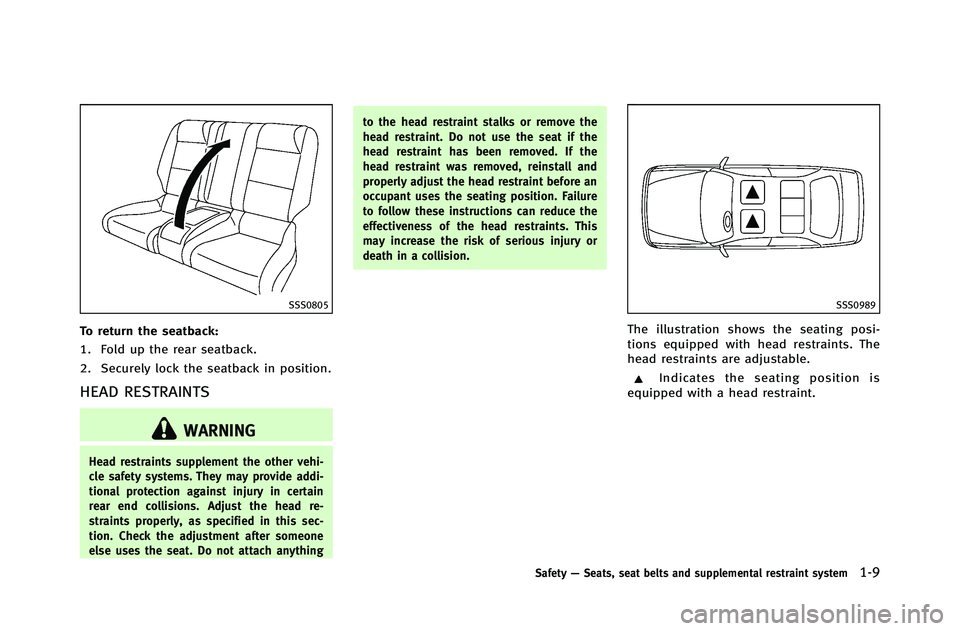
SSS0805
To return the seatback:
1. Fold up the rear seatback.
2. Securely lock the seatback in position.
HEAD RESTRAINTS
WARNING
Head restraints supplement the other vehi-
cle safety systems. They may provide addi-
tional protection against injury in certain
rear end collisions. Adjust the head re-
straints properly, as specified in this sec-
tion. Check the adjustment after someone
else uses the seat. Do not attach anythingto the head restraint stalks or remove the
head restraint. Do not use the seat if the
head restraint has been removed. If the
head restraint was removed, reinstall and
properly adjust the head restraint before an
occupant uses the seating position. Failure
to follow these instructions can reduce the
effectiveness of the head restraints. This
may increase the risk of serious injury or
death in a collision.
SSS0989
The illustration shows the seating posi-
tions equipped with head restraints. The
head restraints are adjustable.
Indicates the seating position is
equipped with a head restraint.
Safety —Seats, seat belts and supplemental restraint system1-9
Page 34 of 490
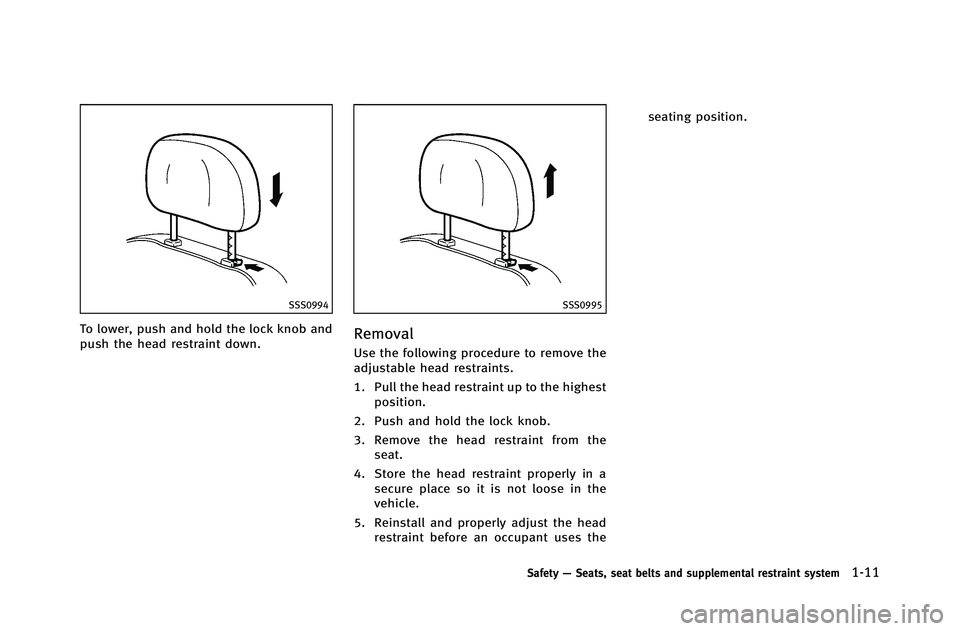
SSS0994
To lower, push and hold the lock knob and
push the head restraint down.
SSS0995
Removal
Use the following procedure to remove the
adjustable head restraints.
1. Pull the head restraint up to the highestposition.
2. Push and hold the lock knob.
3. Remove the head restraint from the seat.
4. Store the head restraint properly in a secure place so it is not loose in the
vehicle.
5. Reinstall and properly adjust the head restraint before an occupant uses the seating position.
Safety
—Seats, seat belts and supplemental restraint system1-11
Page 38 of 490
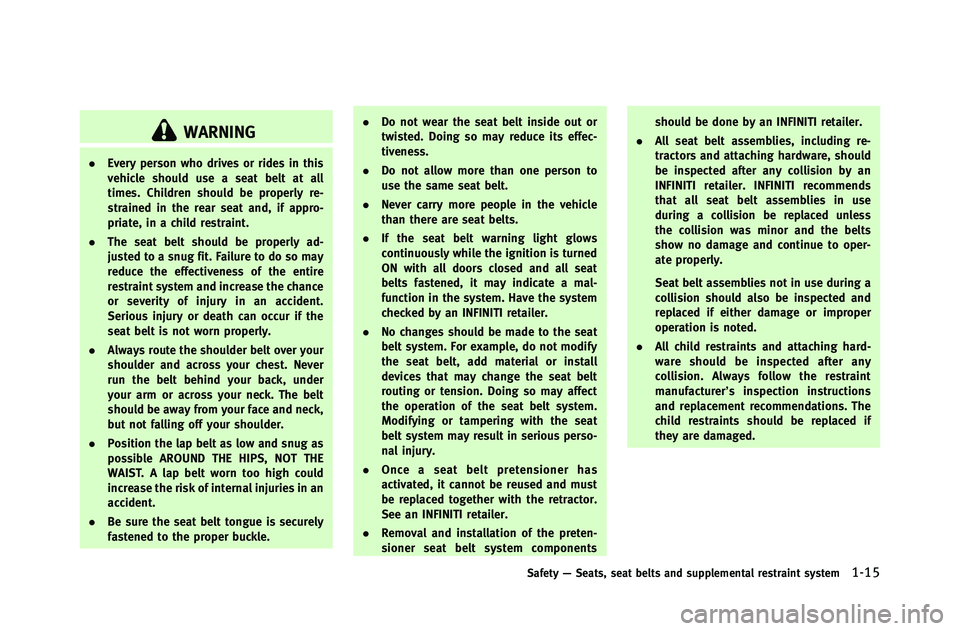
WARNING
.Every person who drives or rides in this
vehicle should use a seat belt at all
times. Children should be properly re-
strained in the rear seat and, if appro-
priate, in a child restraint.
. The seat belt should be properly ad-
justed to a snug fit. Failure to do so may
reduce the effectiveness of the entire
restraint system and increase the chance
or severity of injury in an accident.
Serious injury or death can occur if the
seat belt is not worn properly.
. Always route the shoulder belt over your
shoulder and across your chest. Never
run the belt behind your back, under
your arm or across your neck. The belt
should be away from your face and neck,
but not falling off your shoulder.
. Position the lap belt as low and snug as
possible AROUND THE HIPS, NOT THE
WAIST. A lap belt worn too high could
increase the risk of internal injuries in an
accident.
. Be sure the seat belt tongue is securely
fastened to the proper buckle. .
Do not wear the seat belt inside out or
twisted. Doing so may reduce its effec-
tiveness.
. Do not allow more than one person to
use the same seat belt.
. Never carry more people in the vehicle
than there are seat belts.
. If the seat belt warning light glows
continuously while the ignition is turned
ON with all doors closed and all seat
belts fastened, it may indicate a mal-
function in the system. Have the system
checked by an INFINITI retailer.
. No changes should be made to the seat
belt system. For example, do not modify
the seat belt, add material or install
devices that may change the seat belt
routing or tension. Doing so may affect
the operation of the seat belt system.
Modifying or tampering with the seat
belt system may result in serious perso-
nal injury.
. Once a seat belt pretensioner has
activated, it cannot be reused and must
be replaced together with the retractor.
See an INFINITI retailer.
. Removal and installation of the preten-
sioner seat belt system components should be done by an INFINITI retailer.
. All seat belt assemblies, including re-
tractors and attaching hardware, should
be inspected after any collision by an
INFINITI retailer. INFINITI recommends
that all seat belt assemblies in use
during a collision be replaced unless
the collision was minor and the belts
show no damage and continue to oper-
ate properly.
Seat belt assemblies not in use during a
collision should also be inspected and
replaced if either damage or improper
operation is noted.
. All child restraints and attaching hard-
ware should be inspected after any
collision. Always follow the restraint
manufacturer’ s inspection instructions
and replacement recommendations. The
child restraints should be replaced if
they are damaged.
Safety —Seats, seat belts and supplemental restraint system1-15
Page 41 of 490
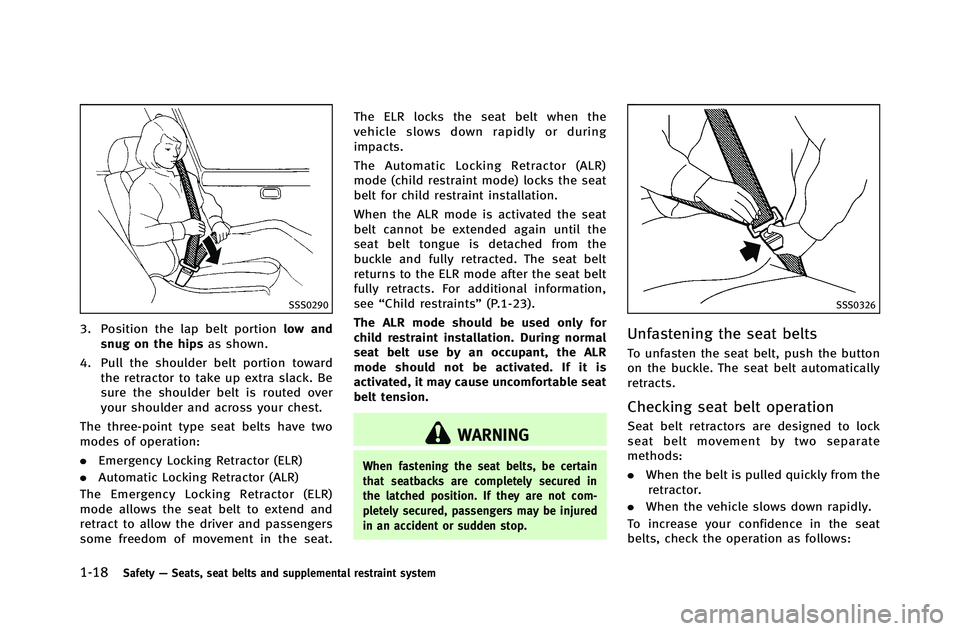
1-18Safety—Seats, seat belts and supplemental restraint system
SSS0290
3. Position the lap belt portion low and
snug on the hips as shown.
4. Pull the shoulder belt portion toward the retractor to take up extra slack. Be
sure the shoulder belt is routed over
your shoulder and across your chest.
The three-point type seat belts have two
modes of operation:
. Emergency Locking Retractor (ELR)
. Automatic Locking Retractor (ALR)
The Emergency Locking Retractor (ELR)
mode allows the seat belt to extend and
retract to allow the driver and passengers
some freedom of movement in the seat. The ELR locks the seat belt when the
vehicle slows down rapidly or during
impacts.
The Automatic Locking Retractor (ALR)
mode (child restraint mode) locks the seat
belt for child restraint installation.
When the ALR mode is activated the seat
belt cannot be extended again until the
seat belt tongue is detached from the
buckle and fully retracted. The seat belt
returns to the ELR mode after the seat belt
fully retracts. For additional information,
see
“Child restraints” (P.1-23).
The ALR mode should be used only for
child restraint installation. During normal
seat belt use by an occupant, the ALR
mode should not be activated. If it is
activated, it may cause uncomfortable seat
belt tension.
WARNING
When fastening the seat belts, be certain
that seatbacks are completely secured in
the latched position. If they are not com-
pletely secured, passengers may be injured
in an accident or sudden stop.
SSS0326
Unfastening the seat belts
To unfasten the seat belt, push the button
on the buckle. The seat belt automatically
retracts.
Checking seat belt operation
Seat belt retractors are designed to lock
seat belt movement by two separate
methods:
. When the belt is pulled quickly from the
retractor.
. When the vehicle slows down rapidly.
To increase your confidence in the seat
belts, check the operation as follows:
Page 43 of 490
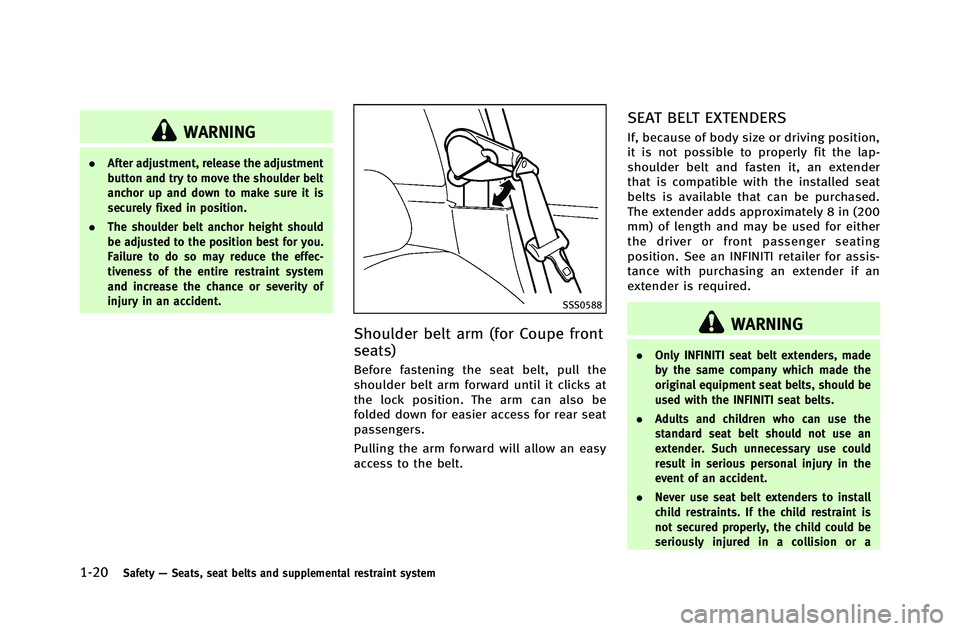
1-20Safety—Seats, seat belts and supplemental restraint system
WARNING
. After adjustment, release the adjustment
button and try to move the shoulder belt
anchor up and down to make sure it is
securely fixed in position.
. The shoulder belt anchor height should
be adjusted to the position best for you.
Failure to do so may reduce the effec-
tiveness of the entire restraint system
and increase the chance or severity of
injury in an accident.
SSS0588
Shoulder belt arm (for Coupe front
seats)
Before fastening the seat belt, pull the
shoulder belt arm forward until it clicks at
the lock position. The arm can also be
folded down for easier access for rear seat
passengers.
Pulling the arm forward will allow an easy
access to the belt.
SEAT BELT EXTENDERS
If, because of body size or driving position,
it is not possible to properly fit the lap-
shoulder belt and fasten it, an extender
that is compatible with the installed seat
belts is available that can be purchased.
The extender adds approximately 8 in (200
mm) of length and may be used for either
the driver or front passenger seating
position. See an INFINITI retailer for assis-
tance with purchasing an extender if an
extender is required.
WARNING
.Only INFINITI seat belt extenders, made
by the same company which made the
original equipment seat belts, should be
used with the INFINITI seat belts.
. Adults and children who can use the
standard seat belt should not use an
extender. Such unnecessary use could
result in serious personal injury in the
event of an accident.
. Never use seat belt extenders to install
child restraints. If the child restraint is
not secured properly, the child could be
seriously injured in a collision or a
Page 45 of 490
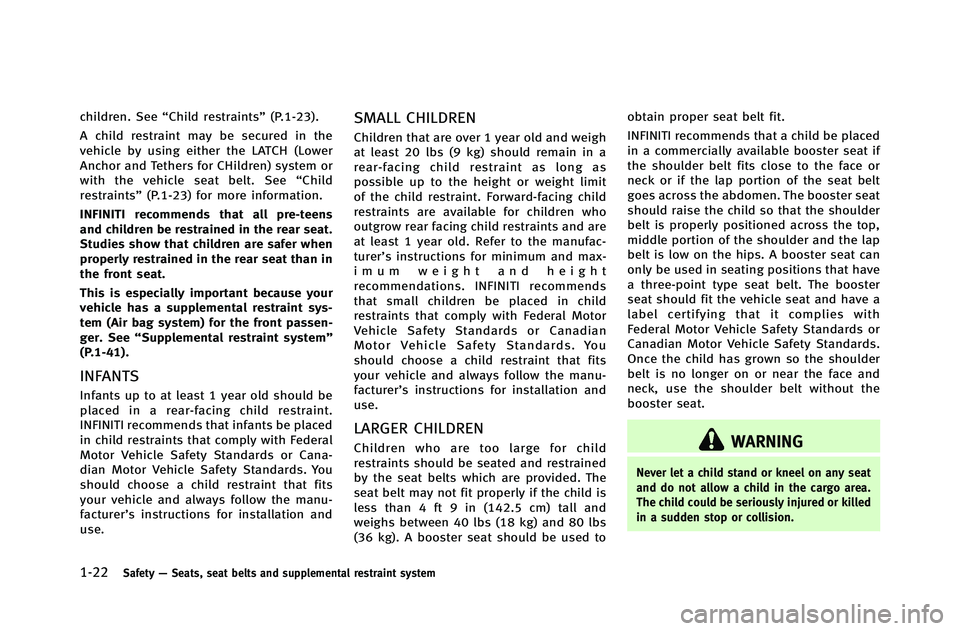
1-22Safety—Seats, seat belts and supplemental restraint system
children. See “Child restraints” (P.1-23).
A child restraint may be secured in the
vehicle by using either the LATCH (Lower
Anchor and Tethers for CHildren) system or
with the vehicle seat belt. See “Child
restraints” (P.1-23) for more information.
INFINITI recommends that all pre-teens
and children be restrained in the rear seat.
Studies show that children are safer when
properly restrained in the rear seat than in
the front seat.
This is especially important because your
vehicle has a supplemental restraint sys-
tem (Air bag system) for the front passen-
ger. See “Supplemental restraint system ”
(P.1-41).
INFANTS
Infants up to at least 1 year old should be
placed in a rear-facing child restraint.
INFINITI recommends that infants be placed
in child restraints that comply with Federal
Motor Vehicle Safety Standards or Cana-
dian Motor Vehicle Safety Standards. You
should choose a child restraint that fits
your vehicle and always follow the manu-
facturer’s instructions for installation and
use.
SMALL CHILDREN
Children that are over 1 year old and weigh
at least 20 lbs (9 kg) should remain in a
rear-facing child restraint as long as
possible up to the height or weight limit
of the child restraint. Forward-facing child
restraints are available for children who
outgrow rear facing child restraints and are
at least 1 year old. Refer to the manufac-
turer’s instructions for minimum and max-
imum weight and height
recommendations. INFINITI recommends
that small children be placed in child
restraints that comply with Federal Motor
Vehicle Safety Standards or Canadian
Motor Vehicle Safety Standards. You
should choose a child restraint that fits
your vehicle and always follow the manu-
facturer’s instructions for installation and
use.
LARGER CHILDREN
Children who are too large for child
restraints should be seated and restrained
by the seat belts which are provided. The
seat belt may not fit properly if the child is
less than 4 ft 9 in (142.5 cm) tall and
weighs between 40 lbs (18 kg) and 80 lbs
(36 kg). A booster seat should be used to obtain proper seat belt fit.
INFINITI recommends that a child be placed
in a commercially available booster seat if
the shoulder belt fits close to the face or
neck or if the lap portion of the seat belt
goes across the abdomen. The booster seat
should raise the child so that the shoulder
belt is properly positioned across the top,
middle portion of the shoulder and the lap
belt is low on the hips. A booster seat can
only be used in seating positions that have
a three-point type seat belt. The booster
seat should fit the vehicle seat and have a
label certifying that it complies with
Federal Motor Vehicle Safety Standards or
Canadian Motor Vehicle Safety Standards.
Once the child has grown so the shoulder
belt is no longer on or near the face and
neck, use the shoulder belt without the
booster seat.WARNING
Never let a child stand or kneel on any seat
and do not allow a child in the cargo area.
The child could be seriously injured or killed
in a sudden stop or collision.
Page 47 of 490
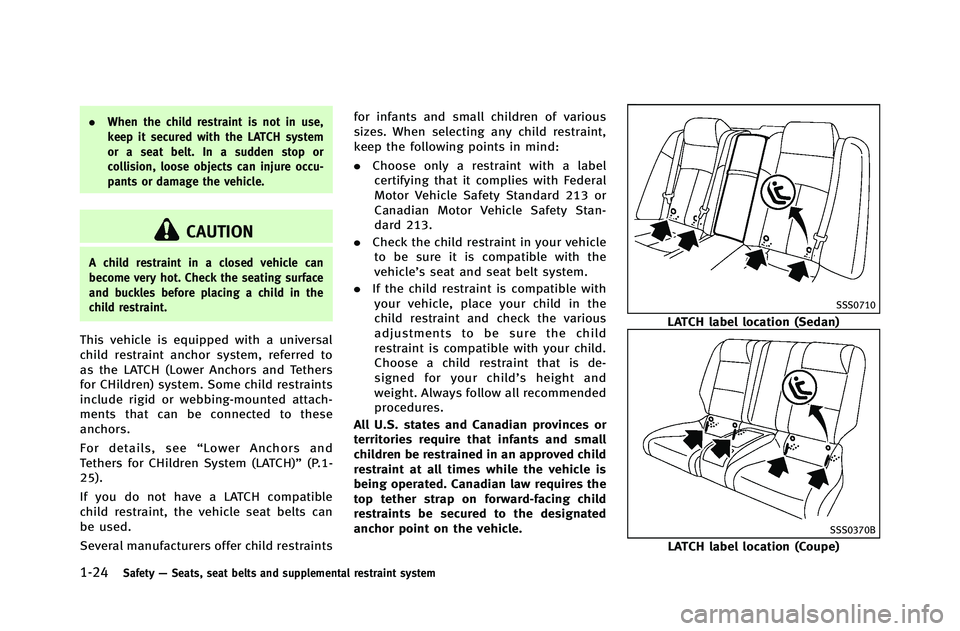
1-24Safety—Seats, seat belts and supplemental restraint system
. When the child restraint is not in use,
keep it secured with the LATCH system
or a seat belt. In a sudden stop or
collision, loose objects can injure occu-
pants or damage the vehicle.
CAUTION
A child restraint in a closed vehicle can
become very hot. Check the seating surface
and buckles before placing a child in the
child restraint.
This vehicle is equipped with a universal
child restraint anchor system, referred to
as the LATCH (Lower Anchors and Tethers
for CHildren) system. Some child restraints
include rigid or webbing-mounted attach-
ments that can be connected to these
anchors.
For details, see “Lower Anchors and
Tethers for CHildren System (LATCH)” (P.1-
25).
If you do not have a LATCH compatible
child restraint, the vehicle seat belts can
be used.
Several manufacturers offer child restraints for infants and small children of various
sizes. When selecting any child restraint,
keep the following points in mind:
.
Choose only a restraint with a label
certifying that it complies with Federal
Motor Vehicle Safety Standard 213 or
Canadian Motor Vehicle Safety Stan-
dard 213.
. Check the child restraint in your vehicle
to be sure it is compatible with the
vehicle’s seat and seat belt system.
. If the child restraint is compatible with
your vehicle, place your child in the
child restraint and check the various
adjustments to be sure the child
restraint is compatible with your child.
Choose a child restraint that is de-
signed for your child’ s height and
weight. Always follow all recommended
procedures.
All U.S. states and Canadian provinces or
territories require that infants and small
children be restrained in an approved child
restraint at all times while the vehicle is
being operated. Canadian law requires the
top tether strap on forward-facing child
restraints be secured to the designated
anchor point on the vehicle.
SSS0710
LATCH label location (Sedan)
SSS0370B
LATCH label location (Coupe)